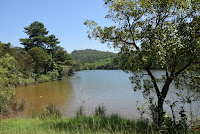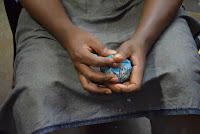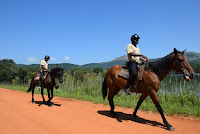Soon after having had breakfast we strolled around the complex having encountered a few mamals and antelope species. I was particularly impressed by the beauty and elegance of the impalas, as well as the features of the common warthog.







We then drove to the Hlane community and prior to having had access to the village visited a small Museum-like room which provided us with some precious information. As women we were not allowed into the village compound before puting a cloth around us. Permission to visit the small community was dependant on the Queen Mother's decision.
She, being quite old but still very energetic conducted a number of day-to-day activities in which we partook in different gender groups (wicker basket braiding and maize grinding in the case of women), as well as the learning and spelling of the local language and a tribal song followed by a dance we learned and subsequently had to perform. It was a very rich cultural experience which allowed us to feel what it would be like to live in such a community as far as daily chores are concerned.












Back to the Mlilwane Camp we had lunch at the compound restaurant before heading to the local market to pay a visit to a well known Swazi candle maker.

Swazi candles are beutifully intricate in both colours and design. It is said they use an ancient technique ("Millefiori") which surfaced in ancient Alexandria and which was later used and perfected by the glass creators in Murano. I was quite impressed and so were most of the people in the group. None of us could resist the beauty of such a craft and we all ended up buying different types of candles. Close by there was a street market displaying other crafts and I ended up buying a colourful local tissue, as well as some painted cards.



(To be continued)





























No comments:
Post a Comment